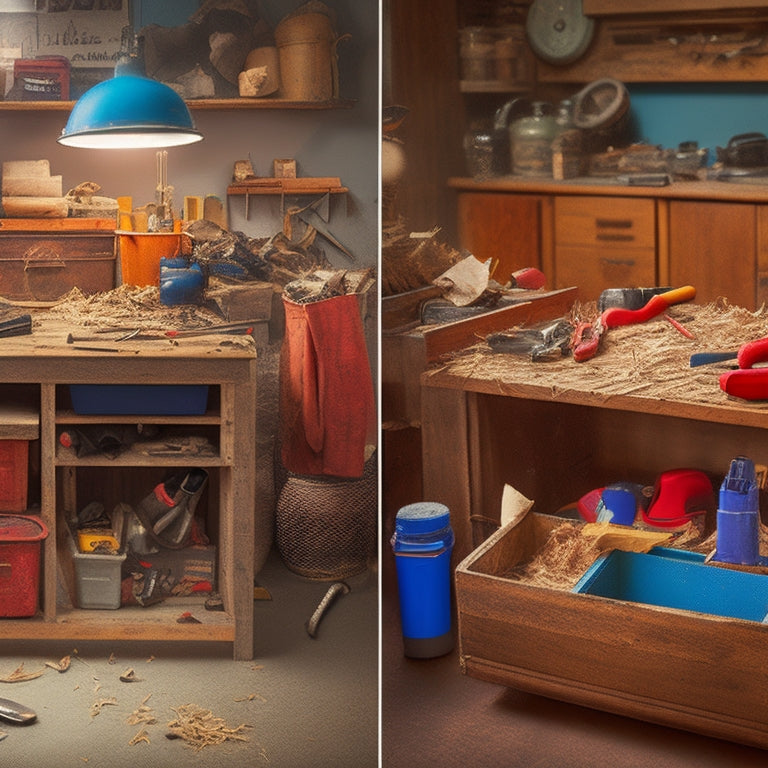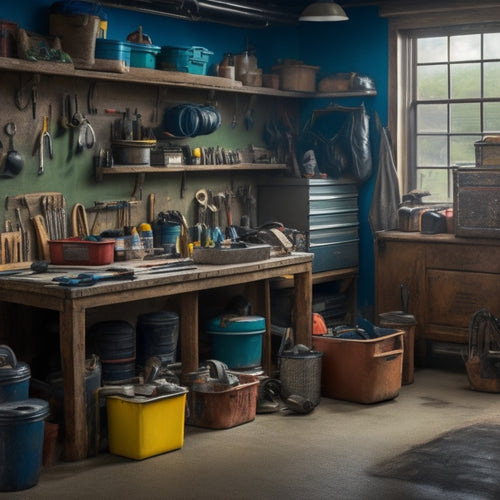
5 Essential Woodworking Hacks to Save Time
Share
You can save hours of wasted time and frustration in your woodworking projects by incorporating five essential hacks into your workflow. Start by organizing your tools strategically, categorizing them into groups and assigning designated spots. Next, streamline your cut list process using digital guides and batch cutting techniques. Take precise measurements to maximize material usage and reduce waste, and utilize story sticks to simplify complex joints and cuts. Finally, optimize your shop layout to reduce downtime and focus on tasks. By implementing these hacks, you'll be able to work more efficiently and effectively, and discover even more secrets to taking your woodworking skills to the next level.
Key Takeaways
• Organize tools strategically to save time and reduce frustration by categorizing and assigning designated spots.
• Implement a systematic approach to creating cut lists using digital cutting guides for accurate measurements and material optimization.
• Take precise measurements to maximize material usage and reduce waste by investing in high-quality tape measures and calipers.
• Utilize a story stick for accurate measurement transfer and break down intricate connections into manageable components.
• Optimize shop layout to streamline workflow and focus on tasks by arranging tools and equipment efficiently and labeling supplies.
Mastering Efficient Tool Organization
Organize your tools strategically, and you'll shave precious minutes off your project timeline by avoiding frustrating searches for misplaced equipment. A well-planned tool storage system is essential for workshop efficiency.
Begin by categorizing your tools into groups, such as hand tools, power tools, and accessories. Assign a designated spot for each category, ensuring that frequently used tools are easily accessible. Consider investing in a pegboard or tool chest with labeled compartments to keep your tools organized and visible. This will help you quickly locate the tool you need, reducing downtime and increasing productivity.
Additionally, maintain a 'clean as you go' mindset to prevent clutter from building up. By implementing these strategies, you'll be able to focus on the task at hand, rather than wasting time searching for lost or misplaced tools. With a well-organized workshop, you'll be amazed at how much more you can accomplish in less time.
Streamlining Your Cut List Process
By implementing a systematic approach to creating your cut lists, you'll reduce errors, minimize waste, and optimize your project's workflow. A well-planned cut list is essential to achieving efficiency in your woodworking projects.
To streamline this process, consider using digital cutting guides that provide accurate measurements and material optimization. This will help you identify the most efficient way to cut your materials, reducing waste and saving you time.
Cut list software can also be a game-changer in streamlining your process. These tools allow you to input your project's specifications and generate a detailed cut list, complete with optimized cutting plans. You can also use batch cutting techniques to cut multiple pieces at once, further reducing your project's workflow.
Reducing Waste With Precision Measurement
You can slash waste and maximize material usage by taking precise measurements, making sure that every cut is accurate and intentional. This attention to detail won't only reduce waste but also improve the overall quality of your projects.
To achieve this, invest in a high-quality tape measure and calipers, and use them consistently. When measuring, take your time and double-check your readings to avoid errors. Additionally, consider using a story stick or measurement template to guarantee consistency across multiple cuts.
By optimizing workflow and improving accuracy, you'll be able to make the most of your materials and reduce the amount of scrap wood. Remember, precise measurements aren't just about reducing waste; they're also essential for building confidence in your skills and producing high-quality work.
With practice, you'll develop a keen eye for measurement and be able to tackle even the most complex projects with ease.
Simplifying Complex Joints and Cuts
Mastering intricate connections and cuts can be a significant hurdle for many woodworkers, but breaking them down into manageable components and leveraging clever techniques can transform even the most daunting projects into achievable realities.
By focusing on precision marking and simplified assembly, you'll be able to tackle intricate connections and cuts with confidence.
Here are three essential techniques to simplify complex connections and cuts:
-
Utilize a story stick: Create a story stick with markings for each connection or cut, allowing you to accurately transfer measurements to your workpiece.
-
Break down intricate connections: Deconstruct intricate connections into smaller, more manageable components, making it easier to assemble and ensure precise fitting.
-
Dry-fit and adjust: Assemble your project without glue, making adjustments as needed to ensure a precise fit, before committing to a permanent bond.
Boosting Productivity With Shop Layout
Optimizing your shop layout can have a profound impact on your productivity, as a well-organized workspace streamlines your workflow and allows you to focus on the task at hand.
By arranging your tools and equipment in a logical and efficient manner, you'll reduce downtime spent searching for misplaced items and eliminate unnecessary steps in your process. This, in turn, enables you to complete projects more quickly and accurately.
To maximize space, consider a modular layout, where tools and workstations can be easily rearranged as needed. This flexibility allows you to adapt to changing project requirements and optimize workflows.
Additionally, label and categorize your tools, materials, and supplies to guarantee everything has a designated home. This not only saves time but also reduces clutter and improves overall shop safety.
Frequently Asked Questions
How Do I Handle Tiny Wood Shavings and Dust in My Workshop?
When tackling tiny wood shavings and dust, you'll want to prioritize dust management and cleanup. Contain wood shavings with a vacuum or dust collector, and dispose of them properly to maintain a safe and organized workshop.
What Safety Gear Is Essential for Woodworking Beginners?
'You'll deliberately dodge devastating dangers by donning decent safety gear, like dust masks, safety glasses, and ear protection, to prevent beginner mistakes and guarantee a healthy, hazard-free woodworking experience.'
Can I Use Reclaimed or Salvaged Wood for Woodworking Projects?
You can definitely use reclaimed or salvaged wood for woodworking projects, embracing woodworking ethics and sustainability. This creative upcycling idea reduces waste, preserves history, and adds unique character to your pieces, making them truly one-of-a-kind.
How Do I Prevent Wood From Warping or Splitting During Drying?
As you carefully coax wood to dry, prevent warping and splitting by shielding it from moisture, embracing air drying or kiln drying techniques to thwart mold's sneaky grasp, and ensuring a steady, controlled environment.
Are There Any Eco-Friendly Wood Finishes and Stains Available?
You'll find plenty of eco-friendly wood finishes and stains on the market, offering sustainable options that are gentle on the environment. Look for organic, non-toxic finishes made from natural ingredients like plant oils, wax, and natural resins.
Related Posts
-

10 Essential Steps for Small Parts Bin Storage
To optimize your small parts bin storage, start by defining your storage needs and goals, considering factors like av...
-

Creative Workshop Storage Solutions and Ideas
You can revolutionize your workshop's storage by maximizing vertical space with wall-mounted racks, utilizing hidden ...
-

Best Cheap Tool Boxes for Budget-Conscious Buyers
You need a reliable tool box that gets the job done without breaking the bank. Look for durable materials, rust-resis...


